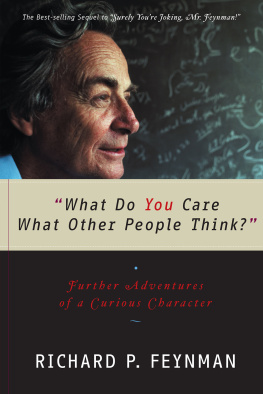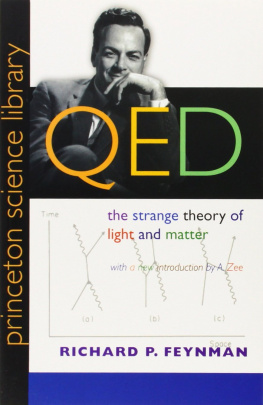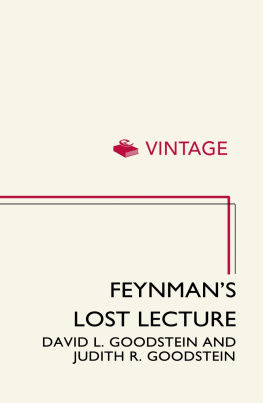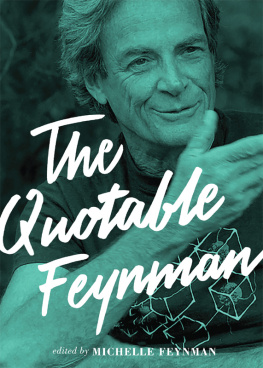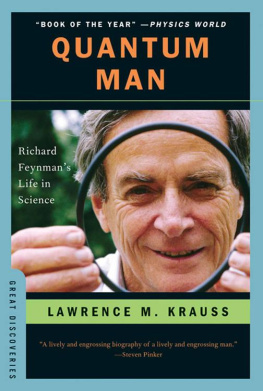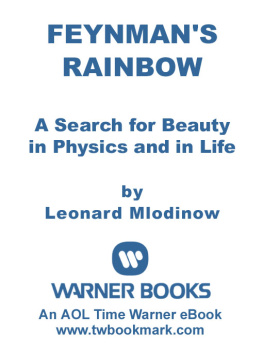PENGUIN BOOKS
WHAT DO YOU CARE WHAT
OTHER PEOPLE THINK?
Richard P. Feynman was one of this centurys most brilliant theoretical physicists and original thinkers. Born in Far Rockaway, New York, in 1918, he studied at the Massachusetts Institute of Technology, where he graduated with a BS in 1939. He went on to Princeton and received his Ph.D. in 1942. During the war years he worked at the Los Alamos Scientific Laboratory. He became Professor of Theoretical Physics at Cornell University, where he worked with Hans Bethe. He all but rebuilt the theory of quantum electrodynamics and high-energy physics and it was for this work that he shared the Nobel Prize in 1965. Feynman was a visiting professor at the California Institute of Technology in 1950, where he later accepted a permanent faculty appointment, and became Richard Chace Tolman Professor of Theoretical Physics in 1959. He had an extraordinary ability to communicate his science to audiences at all levels, and was a well-known and popular lecturer. Richard Feynman died in 1988 after a long illness. Freeman Dyson, of the Institute for Advanced Study in Princeton, New Jersey, called him the most original mind of his generation, while in its obiturary The New York Times described him as arguably the most brilliant, iconoclastic and influential of the postwar generation of theoretical physicists.
A number of collections and adaptations of his lectures have been published, including The Feynman Lectures on Physics, QED (Penguin, 1990) The Character of Physical Law (Penguin, 1992), Six Easy Pieces (Penguin 1998), The Meaning of It All (Penguin 1999), Six Not-So-Easy Pieces (Penguin, 1999), The Feynman Lectures on Gravitation (Penguin, 1999) and The Feynman Lectures on Computation (Penguin, 1999). His memoirs, Surely Youre Joking, Mr Feynman, were published in 1985.
What Do You Care What Other People Think?
Further Adventures of a Curious Character
Richard P. Feynman
as told to Ralph Leighton
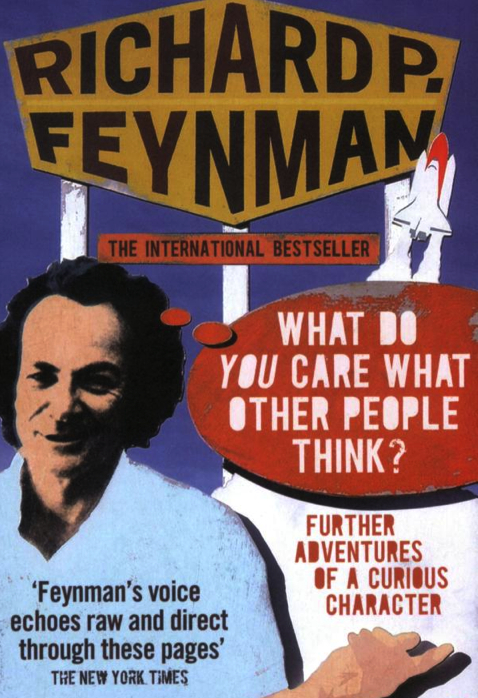
PENGUIN BOOKS
PENGUIN BOOKS
Published by the Penguin Group
Penguin Books Ltd, 80 Strand, London WC2R 0RL, England
Penguin Group (USA) Inc., 375 Hudson Street, New York, New York 10014, USA
Penguin Group (Canada), 90 Eglinton Avenue East, Suite 700, Toronto, Ontario, Canada M4P 2Y3 (a division of Pearson Penguin Canada Inc.)
Penguin Ireland, 25 St Stephens Green, Dublin 2, Ireland (a division of Penguin Books Ltd)
Penguin Group (Australia), 250 Camberwell Road, Camberwell, Victoria 3124, Australia (a division of Pearson Australia Group Pty Ltd)
Penguin Books India Pvt Ltd, 11 Community Centre, Panchsheel Park, New Delhi 110 017, India
Penguin Group (NZ), 67 Apollo Drive, Rosedale, North Shore 0632, New Zealand (a division of Pearson New Zealand Ltd)
Penguin Books (South Africa) (Pty) Ltd, 24 Sturdee Avenue, Rosebank, Johannesburg 2196, South Africa
Penguin Books Ltd, Registered Offices: 80 Strand, London WC2R 0RL, England
www.penguin.com
First published in the United States of America 1988
First published as a Norton paperback 2001
Published in Penguin Books 2007
Copyright Gweneth Feynman and Ralph Leighton, 1988 All rights reserved
The moral right of the author has been asserted
Except in the United States of America, this book is sold subject to the condition that it shall not, by way of trade or otherwise, be lent, re-sold, hired out, or otherwise circulated without the publishers prior consent in any form of binding or cover other than that in which it is published and without a similar condition including this condition being imposed on the subsequent purchaser.
ISBN: 978-0-14-193758-8
Contents
Preface
BECAUSE of the appearance of Surely Youre Joking, Mr. Feynman! a few things need to be explained here.
First, although the central character in this book is the same as before, the adventures of a curious character here are different: some are light and some tragic, but most of the time Mr. Feynman is surely not jokingalthough its often hard to tell.
Second, the stories in this book fit together more loosely than those in Surely Youre Joking, where they were arranged chronologically to give a semblance of order. (That resulted in some readers getting the mistaken idea that SYJ is an autobiography.) My motivation is simple: ever since hearing my first Feynman stories, I have had the powerful desire to share them with others.
Finally, most of these stories were not told at drumming sessions, as before. I will elaborate on this in the brief outline that follows.
the past ten years out of pieces from six different stories. When it was finally complete, Feynman was especially fond of this story, and happy to share it with others.
The other Feynman stories in have been provided courtesy of Gweneth Feynman, Freeman Dyson, and Henry Bethe.
, Mr. Feynman Goes to Washington, is, unfortunately, Feynmans last big adventure. The story is particularly long because its content is still timely. (Shorter versions have appeared in Engineering and Science and Physics Today.) It was not published sooner because Feynman underwent his third and fourth major surgeriesplus radiation, hyperthermia, and other treatmentssince serving on the Rogers Commission.
Feynmans decade-long battle against cancer ended on February 15, 1988, two weeks after he taught his last class at Caltech. I decided to include one of his most eloquent and inspirational speeches, The Value of Science, as an epilogue.
Ralph Leighton
March 1988
Part 1
A CURIOUS CHARACTER
The Making of a Scientist
I HAVE a friend whos an artist, and he sometimes takes a view which I dont agree with. Hell hold up a flower and say, Look how beautiful it is, and Ill agree. But then hell say, I, as an artist, can see how beautiful a flower is. But you, as a scientist, take it all apart and it becomes dull. I think hes kind of nutty.
First of all, the beauty that he sees is available to other peopleand to me, too, I believe. Although I might not be quite as refined aesthetically as he is, I can appreciate the beauty of a flower. But at the same time, I see much more in the flower than he sees. I can imagine the cells inside, which also have a beauty. Theres beauty not just at the dimension of one centimeter; theres also beauty at a smaller dimension.
There are the complicated actions of the cells, and other processes. The fact that the colors in the flower have evolved in order to attract insects to pollinate it is interesting; that means insects can see the colors. That adds a question: does this aesthetic sense we have also exist in lower forms of life? There are all kinds of interesting questions that come from a knowledge of science, which only adds to the excitement and mystery and awe of a flower. It only adds. I dont understand how it subtracts.
Ive always been very one-sided about science, and when I was younger I concentrated almost all my effort on it. In those days I didnt have time, and I didnt have much patience, to learn whats called the humanities. Even though there were humanities courses in the university that you had to take in order to graduate, I tried my best to avoid them. Its only afterwards, when Ive gotten older and more relaxed, that Ive spread out a little bit. Ive learned to draw and I read a little bit, but Im really still a very one-sided person and I dont know a great deal. I have a limited intelligence and I use it in a particular direction.
Next page


